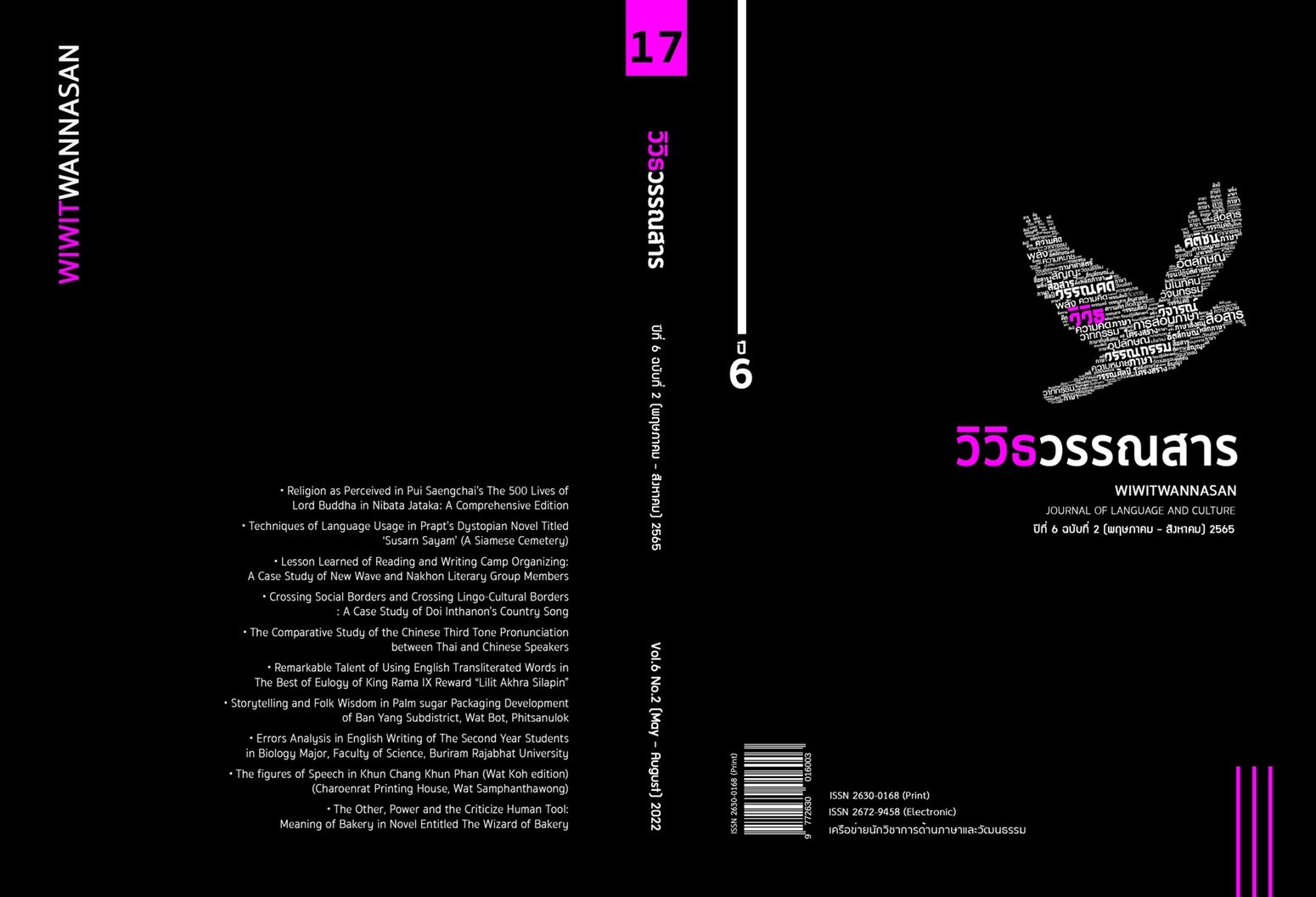ศาสนาที่ปรากฏในชาดกเรื่องพระเจ้า 500 ชาติ ฉบับพิสดาร ของปุ้ย แสงฉาย
Main Article Content
บทคัดย่อ
บทความนี้มีจุดมุ่งหมายเพื่อศึกษาลักษณะของศาสนาที่ปรากฏในชาดกเรื่องพระเจ้า 500 ชาติ ฉบับพิสดารของปุ้ย แสงฉาย โดยอาศัยกรอบแนวคิดเกี่ยวกับลักษณะของศาสนา ผลการศึกษาพบลักษณะของศาสนา 3 ลักษณะ ลักษณะแรก คือ ศาสนาดั้งเดิม ได้แก่ ศาสนาที่เชื่อเกี่ยวกับวิญญาณ ผี การนับถือผีบรรพบุรุษ การนับถือธรรมชาติ และการนับถือสัตว์ที่มีลักษณะแปลก ลักษณะที่สองคือศาสนาแบบเทวนิยมที่เป็นพหุเทวนิยม เทวดาส่วนใหญ่ที่พบในชาดก ได้แก่ พระอินทร์ เทพผู้เป็นบริวารของพระอินทร์ และรุกขเทวดา แต่ไม่ปรากฏความเชื่อเรื่องเทพเจ้าสร้างโลก ลักษณะที่สามคือศาสนาแบบอเทวนิยมในยุคต้นๆ ที่มนุษย์เริ่มแสวงหาความจริงเพื่อความหลุดพ้น และต้องการหาเหตุผลด้วยปัญญาเพื่ออธิบายสิ่งต่างๆ ที่เกิดขึ้นรอบตัวมากกว่าความศรัทธาเพียงอย่างเดียว
Article Details

อนุญาตภายใต้เงื่อนไข Creative Commons Attribution-NonCommercial-NoDerivatives 4.0 International License.
ลิขสิทธิ์ของบทความเป็นของวารสาร การพิมพ์ซ้ำจะต้องได้ร้บการอนุญาตจากบรรณาธิการวารสาร
เอกสารอ้างอิง
Chaiwinit, K. (1988). Primitive religion in Isan folk tales. [Master’s thesis, Srinakharinwirot University Mahasarakham]. (In Thai)
Changkwanyuen, P. & Phromtha, S. (2009). Man and religion. Faculty of Arts, Chulalongkorn University. (In Thai)
Chaocharoenrat, S. (2015). Syncretism: Combining Religious Beliefs. Religious Science. http://sinchaichao.blogspot.com/2015/06/syncretism.html. (In Thai)
Feungfusakun, A. (2008). Anthropology of religion. Faculty of Social Sciences, Chiang Mai University. (In Thai)
Institute of Thai Studies Chulalongkorn University. (n.d.). Phisuea Samudra. https://www.facebook.com/ThaiStudiesCU/posts/1616170571855212/ (In Thai)
Kaewopas, T. (n.d.). World religions in the primitive, prehistoric and present times. Sakon Karn Suksa. (In Thai)
Kongsirirat, S. (2004). Lecture notes on folklore related to Thai language and literature [Unpublished manuscript]. Faculty of Humanities, Naresuan University. (In Thai)
Mahidol Wittayanusorn School. (n.d.). Unit 1: Introduction to religion. https://social.mwit.ac.th/files/55_1_doc_30101_1.pdf (In Thai)
Netnimit, S. (2017). An interdisciplinary analysis of the Buddhist jataka. Journal of Graduate Studies Review, 13 (3), 1-15. (In Thai)
Phantharangsee, S. (1991). Archaic religion. Bangkok: Thammasapa. (In Thai)
Phantharangsee, S. (1999). Comparative religion (8th ed.). Bangkok:Sukkapabjai Publishing. (In Thai)
Prabnok, P. (2015). World religion. Humanities and Social Sciences, 32 (3), 50-69. (In Thai)
Phongsapich, A. (1991). Culture, religion and ethnicity: An anthropological analysis of Thai society. Chulalongkorn University Press. (In Thai)
Puphaka, A. (2016). The translation and publication of Nibata Jataka: A stability ensuring policy in the reign of King Rama V. Parichart Journal, 29 (2), 89-108.
Royal Institute. (2011). The Royal Institute dictionary B.E. 2554. https://dictionary.orst.go.th/ (In Thai)
Saengchai, P. (1961). The 500 lives of Lord Buddha in Nibata Jataka: A comprehensive edition. So Dharmma Phakdee. (In Thai)
Saengchai, P. (2008). The Quarterly Tipitaka. Bangkok: So. Dharmma Phakdee. (In Thai)
Saeong, P. (2019). Greco-Roman and Indian gods with relations to nature. Wiwitwannasan, 3 (1), 79-99. (In Thai)
Sirarojjananan, M. (2018). Indra in Theravada Buddhist Texts. Mahachula Academic Journal.
(1), 44-63. (In Thai)
Sirichaiwattanayothin, S. (2018). An Analytical Study of Indra’s Roles in Jataka Tales.
[Master’s thesis, Mahachulalongkornrajavidyalaya University]. (In Thai)
Vajirayana Library. (2009). Pannasa Jataka. https://tinyurl.com/yhbfcwv2. (In Thai)
Wichitwathakan, L. (2003a). World religion volume 1. Sangsan Books Ltd. (In Thai)
Wichitwathakan, L. (2003b). World religion volume 2. Sangsan Books Ltd. (In Thai)


